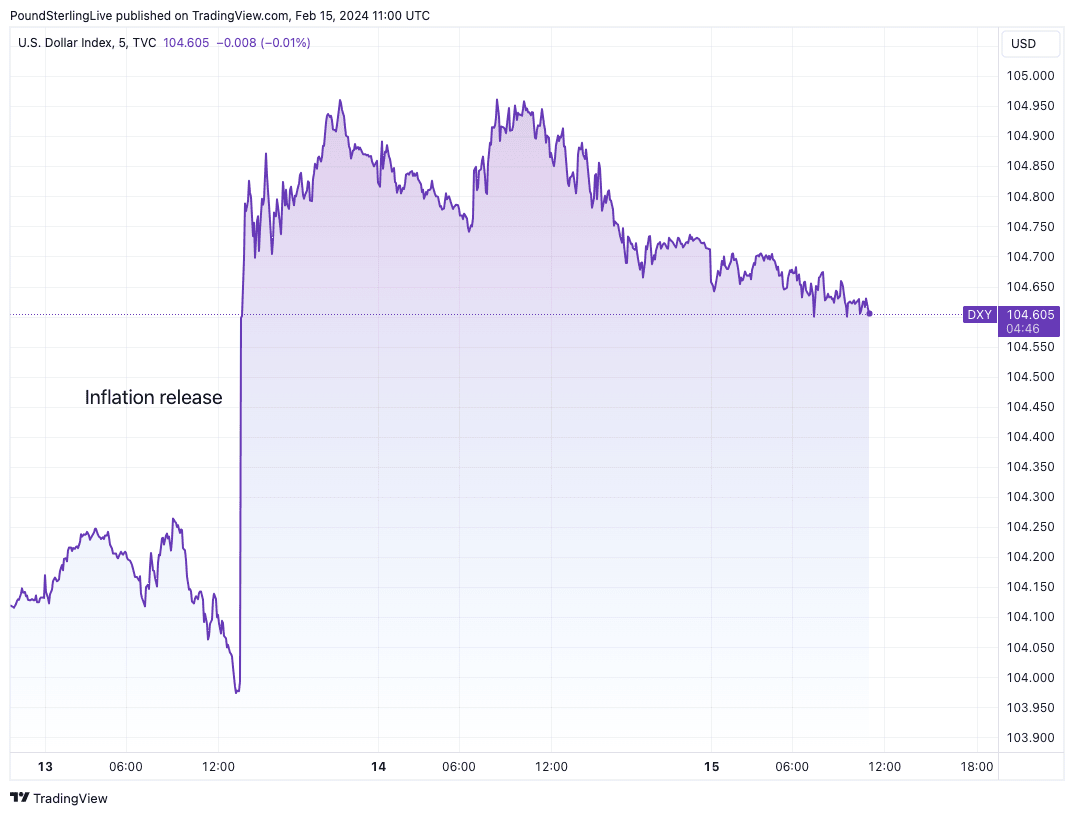
Above: File image of Austan Goolsbee. Image: Center for American Progress Action Fund / UNLV Photo Services / GERI KODEY. Licensing: CC BY-ND 2.0 DEED Attribution-NoDerivs 2.0 Generic.
Written by Charalampos Pissouros, Senior Investment Analyst at XM.com. An original version of this article can be read here.
The U.S. dollar pulled back against all but one of its major peers on Wednesday, as traders may have decided to consolidate gains after Tuesday’s hotter-than-expected US inflation data and ahead of today’s retail sales report.
What may have prompted investors to lock some CPI-related gains may have been comments by Chicago Fed President Austan Goolsbee, who said that the Fed’s path will stay on track even if inflation runs a bit hotter than expected in coming months, adding that the central bank should be careful of not waiting too long before it cuts interest rates.
That said, the market did not add to its rate cut bets after Goolsbee’s remarks.
Above: U.S. Dollar index – a measure of broad USD performance – at 5-minute intervals.
Investors still believe that a first 25bps reduction will be delivered in June, while the total number of basis points worth of cuts expected for the whole year remained at around 95.
This suggests that following the latest upbeat economic data investors may be more willing to adjust their path upwards rather than downwards from here onwards.
With that in mind, they may pay extra attention to today’s US retail sales for January.
Expectations are for the headline m/m rate to have slid to -0.2% from 0.6%, while core sales are anticipated to have slowed to 0.2% from 0.4%. These numbers could weigh a bit on the US dollar, but due to the stellar jobs report and the hot CPI data for the month, they are unlikely to materially impact expectations about the Fed’s future course of action.
On the other hand, an upside surprise could result in some further upside adjustments to the market’s implied path.
The only currency that the dollar did not lose ground against was the British pound, which suffered after yesterday’s CPI numbers revealed that inflation in the UK did not accelerate as it was anticipated.
Sterling continued drifting south today, after the preliminary GDP data for Q4 pointed to a 0.3% q/q contraction, confirming that the UK economy has fallen into technical recession. Market participants brought forth their rate cut bets, raising the probability for the BoE to start cutting rates in June to 70% from 50%. For the pound to take a breather after the CPI and GDP data, tomorrow’s retail sales numbers may need to come in relatively upbeat.
Track USD and GBP with your own custom rate alerts. Set Up Here
The yen gained some ground yesterday and continued to do so today, even after Japan’s GDP data revealed that this nation has also slipped into recession. What makes the release even more interesting is that the unexpected contraction in Q4 saw Japan losing its status as the world’s third-largest economy to Germany.
Yet, yen traders are likely considering the upcoming spring wage negotiations, the BoJ’s policy communication, and the finance ministry’s stance on the yen as more important. Following the latest intervention warnings by Japan’s top currency diplomat Kanda and finance minister Suzuki, traders may have been reluctant to sell the yen. That said, a stronger dollar could still push the dollar/yen pair higher and thereby increased the chances of actual action by Japanese authorities.
The pullback in the dollar was accompanied by a slide in Treasury yields, which helped US equities close in the green. The Nasdaq was the main gainer as ride-hailing platforms Uber and Lyft skyrocketed while Nvidia passed Alphabet as Wall Street’s third most valuable company.
This confirms the notion that even if the market continues to upwardly adjust its Fed implied path, any pullbacks in equities are likely to prove to be just a correction before the next leg north. Data suggesting that the US economy is firing on all cylinders and investors seemingly not fully pricing in future growth opportunities with regards to artificial intelligence are likely to allow the S&P 500 to conquer new record highs again very soon.
Oil prices pulled back yesterday after the Energy Information Administration (EIA) said that US crude inventories jumped by 12mn barrels, well surpassing the 2.6bn barrels rise expected by analysts polled by Reuters. That said, with no breakthrough in ceasefire talks in the Middle East and with two OPEC+ members – Kazakhstan and Iraq – saying that they will address any excess output above the agreed voluntary cuts, any declines are likely to stay limited.







